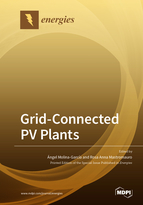Grid-Connected PV Plants
A special issue of Energies (ISSN 1996-1073). This special issue belongs to the section "A2: Solar Energy and Photovoltaic Systems".
Deadline for manuscript submissions: closed (30 April 2020) | Viewed by 26552
Special Issue Editors
Interests: wind energy; PV power plants; energy efficiency; renewable energy source integration into power systems
Special Issues, Collections and Topics in MDPI journals
Interests: power converters and control techniques for renewable energy systems; smart grids; transportation applications
Special Issues, Collections and Topics in MDPI journals
Special Issue Information
Dear Colleagues,
The Energies Journal is running a Special Issue on the topic of Grid-Connected PV Plants. PV power plant integration into the grid has been a relevant topic of interest over the last years. Policies supported by governments, technology maturity, favourable incentives, and cost decreasing have significantly promoted the integration of PV power plants into power systems at a transmission and distribution level. Nevertheless, there are some barriers in terms of forecasting generation, grid reliability, and power quality, which are crucial to overcome in order for a massive PV integration into future power systems. Additionally, the ancillary services provided by these generation units are more and more required by different agents in order to facilitate grid operation under a high presence of renewables.
Topics of interest for this Special Issue include, but are not limited to, the following areas:
- Large-scale PV power plants
- Energy policies related to PV power plants
- Grid integration and interaction
- PV power plant modeling
- Monitoring and case studies
- Communication systems for PV power plant integration
- Economic analyses
- PV inverters and sizing analyses
- New trends in PV technologies
- Reviews
Prof. Dr. Ángel Molina-García
Prof. Dr. Rosa Anna Mastromauro
Guest Editors
Manuscript Submission Information
Manuscripts should be submitted online at www.mdpi.com by registering and logging in to this website. Once you are registered, click here to go to the submission form. Manuscripts can be submitted until the deadline. All submissions that pass pre-check are peer-reviewed. Accepted papers will be published continuously in the journal (as soon as accepted) and will be listed together on the special issue website. Research articles, review articles as well as short communications are invited. For planned papers, a title and short abstract (about 100 words) can be sent to the Editorial Office for announcement on this website.
Submitted manuscripts should not have been published previously, nor be under consideration for publication elsewhere (except conference proceedings papers). All manuscripts are thoroughly refereed through a single-blind peer-review process. A guide for authors and other relevant information for submission of manuscripts is available on the Instructions for Authors page. Energies is an international peer-reviewed open access semimonthly journal published by MDPI.
Please visit the Instructions for Authors page before submitting a manuscript. The Article Processing Charge (APC) for publication in this open access journal is 2600 CHF (Swiss Francs). Submitted papers should be well formatted and use good English. Authors may use MDPI's English editing service prior to publication or during author revisions.
Keywords
- grid-connection
- grid-interaction
- inverter technology
- PV module
- energy policy
- economics







